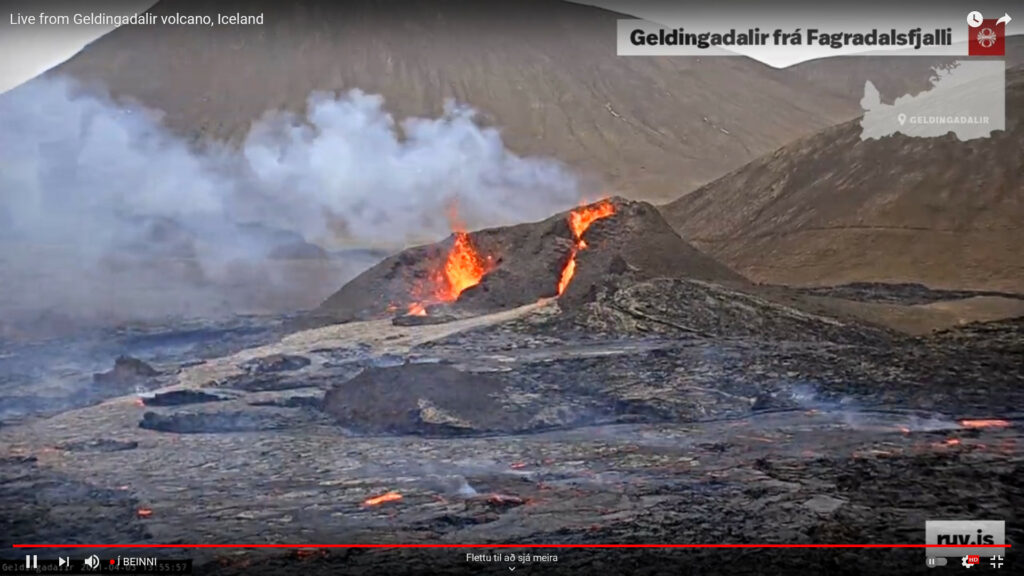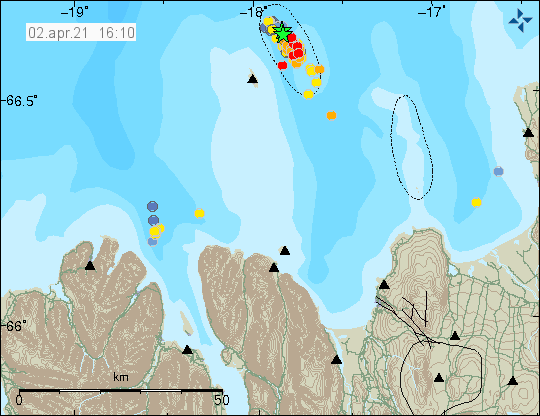This is a short update of the activity in the eruption in Geldingadalir valley (former, as the valley has now filled up with lava or close to being filled with lava). The eruption is taking place in Krýsuvík-Trölladyngja volcano system. The eruption has been stable all week. On Sunday 28-March-2021 other side of the craters that had built up collapsed into the lava stream that has formed below the erupting craters. Both craters are now about equal erupting size.
- The lava that is now erupting is primitive Tholeiitic magma based on the chemical analyse from University of Iceland. That report can be found here (pdf).
- Both craters are unstable and often suffer a collapse and rock slides and that often changes their look suddenly and drastically in a moment.
- Icelanders continue to act like idiots in front of the web cameras that show the eruption online (I think all of them). The Rúv web camera is a large structure there that is easy to avoid (with solar panels and everything).
- Lava boiling is a common occurrence that often breaks up through the newly formed crust in the new lava field. This happens without warning and often reshapes the lava field in a instance.
- Spatter activity in the eruption craters often drops but the flow of lava seems to be stable based on the web cameras and observation reported in the news by volcano scientists according to the latest news I was able to find.
- It is unclear when lava is going to start flowing out of Geldingadalir valley (former). It might start to happen this weekend or by next week.
- Based on what I am observing on the web cameras at the writing of this article. A collapse might happen in the erupting crater on the right side on the screen (I don’t know what is north and south on the web camera). When that or if that happens is impossible to know, but the whole structure that I am seeing doesn’t look that stable when I write this article.
- At the writing of this article a large collapse took place in the erupting crater on the left side on the camera. Resulting in block of the erupting vent and resulting in a lot of spatter activity as a result as it clears it self of the rock that fell into it.
Currently there are no signs of this eruption about to end. This eruption might go on for a long time. Next update about the eruption in Geldingadalir valley (former) should be on 9-April-2021 unless something major happens in the eruption.
Update 14:12 UTC on 3-April-2021

There is now in the northern crater (right side on screen?) a small lava fall. Its not big but it is few meters high. There are variations in spatter activity and the whole crater structure remains unstable. There are many collapses and changes now over one day.
Donations
Please remember to support my work with donations. It helps me keeping everything going. Thanks for the support. 🙂
Cloudflare
I have now added Cloudflare to this website. That should prevent any problem with using it when a large spike in traffic happens as was the case when the eruption in Geldingadalir valley first started.
Advertisements
I re-applied to Amazon Associate accounts and that is now active but my website has to make a sale in next 180 days to make that permanent again. This rule also applies to old accounts. If you shop from Amazon using the Amazon banners (United Kingdom, United States, Germany) gives me a little extra income.
Article updated at 14:12 UTC on 3-April-2021

